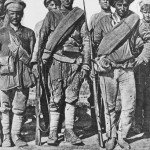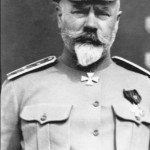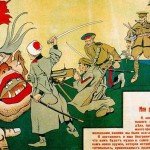
Broadly speaking, the White armies (also known as White Guards or simply Whites) were military forces that participated in the Russian Civil War. The White armies fought against the Bolshevik Red Army for control of Russia. Unlike the Bolsheviks, the White armies did not share a single ideology, methodology or political goal. They were led by conservative generals with different agendas and methods and, for the most part, they operated quite independently of each other, with little coordination or cohesion. The composition and command structure of White armies also varied, some containing hardened veterans of World War I, others more recent volunteers. These differences and divisions, along with their inability to offer an alternative government and win popular support, prevented the White armies from winning the Civil War.
Anti-Bolshevik militias and military units were formed in piecemeal fashion in mid-1918, prompted by the uprising of the Czech Legion. There was no planning or coordination: units simply formed in response to local conditions, events or Bolshevik policy. Together they became known as the Whites, an umbrella term that described anyone opposed to Lenin and his government. Because the colour white was traditionally associated with the Romanov monarchy, the implication was that the White armies were monarchist, however this was not always true. Large numbers of republicans, liberals, democrats and non-Bolshevik socialists fought with or alongside White counter-revolutionary forces. The Whites were not just volunteers either. Like the Red Army, several White armies filled their ranks by conscripting peasants in areas they controlled.

Most White forces were commanded by former tsarist generals of varying skill and expertise. The infamous General Kornilov commanded a White force in southern Russia before his early death in April 1918. His successor, General Anton Denikin, attempted an assault on Moscow in 1919, before being pushed back toward Crimea. Also leading a White army in the south was Pyotr Wrangel, a distinguished veteran of World War I who had attained general rank in 1917. Wrangel proved a more patient and perceptive leader than Denikin. While Denikin wanted to lay siege to Moscow, Wrangel preferred to wait until his forces could link up with Admiral Kolchak’s army in the east. Unlike most of his fellow White generals, Wrangel was also a capable administrator, who recognised the need for public support.
“The nature of the civil war meant that White authority in those parts of Russia not controlled by the Bolsheviks remained tenuous, not to say ephemeral. The ability of the generals to maximise the resource potential of often vast regions remained pitifully weak and largely depended on non-Bolshevik and mainly leftist parties to supply the necessary cadres for administration.”
Mark Levene, historian
Admiral Alexander Kolchak was a career naval officer and polar explorer who became the dictatorial leader of White-held Siberia. Anti-Bolshevik forces established a coalition government in Siberia in 1918, before Kolchak was installed as leader following a British-back coup. Kolchak quickly assumed dictatorial powers and became the closest thing Russia had to a ‘White tsar’. He promised to drive the Bolsheviks from power, however, his campaign also extended to non-Bolshevik socialists, thousands of whom were murdered during Kolchak’s rule. In March 1919 Kolchak’s army began a westward push into Bolshevik-held territory, advancing as far as Kazan and Samara. The offensive ran out of steam, however, and was eventually pushed back. By late 1919 Kolchak was extremely unpopular, both with the Russians under his rule and the foreign governments who had backed him. In January 1920 Kolchak was betrayed and handed over to local Bolsheviks in Irkutsk. He was interrogated and executed by firing squad.
General Nikolai Yudenich, the oldest of the White military commanders, controlled the White army in north-western Russia. A 40-year army veteran, Yudenich was leading operations against the Ottoman Empire in the Caucasus when the revolution erupted. He was forced into retirement by Kerensky and spent much of 1918 in hiding from the Bolsheviks. By late 1918 Yudenich had reappeared to assume control of anti-Bolshevik forces along the Baltic coast. Supported and encouraged by the British, Yudenich launched an attack on Petrograd in October 1919. With much of the Red Army occupied in Siberia and southern Russia, Yudenich’s offensive was very nearly successful, coming within just a few miles of the capital. His forces failed to gain control of the railways, however, which allowed the Bolsheviks to quickly bring in reinforcements from the south. Yudenich and his army were pushed back into the Baltic states. The general himself later fled the region, his bags reportedly filled with large amounts of cash supplied by foreign governments.

These White generals were often mocked or satirised in Soviet propaganda. The most common accusation was that they were anti-Russian agents, or that they were being bribed by the capitalist governments of Britain, France and the United States. One Viktor Deni cartoon, Dogs of War, shows Denikin, Kolchak and Yudenich controlled by a leash wielded by these foreign powers. The Whites themselves were avid creators of political propaganda, though it was not as prolific or as effective as Bolshevik material. White propaganda drew heavily on the horrors of the Red Terror, the CHEKA and war communism. It depicted the Bolshevik movement as bloodthirsty, anti-religious and destructive. Some White propaganda also drew on traditional hatreds, particularly anti-Semitism, with Trotsky a particular target.
The failure of the White armies and their commanders can be explained in two points. First, the White forces were divided, geographically separated and either unable or unwilling to coordinate their efforts. White generals did work together at times, however, they also operated autonomously and with their own agendas. This disunity and lack of coordination proved militarily fatal. Second, the Whites failed to offer ordinary Russians a viable alternative to the Bolshevik regime. For the entirety of the Civil War, it was unclear what kind of government Russia might inherit if the Whites were victorious. White leaders offered no promise or hope for the future, only a return to either tsarism or the uncertainty of 1917. The White armies often treated ordinary Russians appallingly and many White commanders relied on the same brutal tactics – conscription, grain requisitioning, coercion and terror – as their Bolshevik counterparts. There was often little to distinguish between Red and White rule, so many Russians supported neither.

1. The White armies were several anti-Bolshevik militias and military forces that fought in the Russian Civil War.
2. Aside from their opposition to the Bolsheviks, the White armies had little in common and featured different composition, leadership and methods.
3. White army commanders were mostly former tsarist generals who assumed control of anti-Bolshevik forces in particular regions.
4. The White armies failed largely because of their inability or unwillingness to communicate and coordinate, meaning their forces were divided.
5. The White armies also failed to provide a political alternative to Bolsheviks, promising little or nothing other than their removal. Many White commanders and officers also restored to the same methods and coercion used by the Red Army and CHEKA, which made them unpopular with locals.
